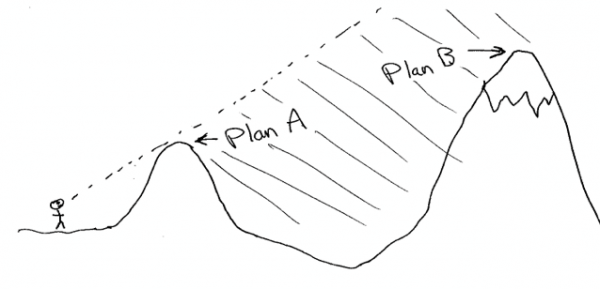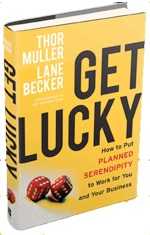This post is part of an ongoing series entitled “a post a day for the month of may.” It’s an unfolding exploration of the concepts from the book “Get Lucky.”
“See and be seen.” If parallax and vantage operate on the “see” side of things, mental real estate is the “be seen” side (or more accurately, “be thought of”). It’s the total square footage of thought you occupy across the collective minds of everyone you’ve ever affected. And if Chip & Dan Heath (authors of “Made to Stick” and contributors of a testimonial for “Get Lucky”) are right, then your ability to persist in the minds of others may trump every other skill. To understand the importance of “mental real estate” we need to look more at a theory Lane and Thor referenced called the “weak tie hypothesis.”
 This theory surfaced in mainstream media about six months back in conjunction with some new research purporting that the “Six Degrees of Kevin Bacon” theory was actually way off and it’s closer to 4.74 degrees of separation. Or put into a less abstract form: of the 6.8BN people on this rock if you were to put everyone’s name in a hat and choose just one, odds are a friend of your friend knows a friend of their friend. The “Get Lucky” authors discuss this idea later in the book (CH 7 – we’re jumping the gun a bit) while talking about “needle in haystack” problems making the point that brute force methods to solve haystack problems are becoming ineffective. The haystacks are simply becoming too large and the needles too microscopic for the traditional sorting methods to work – a network-based approach is essential at this scale. Essentially, tell yo friends to get wit my friends and we can be friends.
This theory surfaced in mainstream media about six months back in conjunction with some new research purporting that the “Six Degrees of Kevin Bacon” theory was actually way off and it’s closer to 4.74 degrees of separation. Or put into a less abstract form: of the 6.8BN people on this rock if you were to put everyone’s name in a hat and choose just one, odds are a friend of your friend knows a friend of their friend. The “Get Lucky” authors discuss this idea later in the book (CH 7 – we’re jumping the gun a bit) while talking about “needle in haystack” problems making the point that brute force methods to solve haystack problems are becoming ineffective. The haystacks are simply becoming too large and the needles too microscopic for the traditional sorting methods to work – a network-based approach is essential at this scale. Essentially, tell yo friends to get wit my friends and we can be friends.
So doesn’t this have more to do with their theory of connectedness? Why bring this idea up now in the context of motion? Because as humans we’ve evolved to be particularly attuned to movement – we’re hardwired such that we can’t help but notice it. And our wacky movements when made in the pursuit of passions are what stand out and get cemented in the minds of others. If the 4.74 figure of connectedness from this new research is true and the concepts of “Made to Stick” accurate (ie. the transmissibility of a message is subservient to how well it sticks) then improving our ability to stake out mental real estate in the minds of those we touch will have multiplicative effects on increasing the surface area of this imaginary net that’s trolling the cosmos on our behalf.
Think of the concentric spheres of people who occupy your head and heart. It’s likely your spouse or significant other followed by a ring of family, followed by a ring of close friends, internet friends, acquaintances, familiar faces, strangers, etc. With the massive reach represented by each person at every orbit, we are all just a neuronal firing away from being relevant in a random conversation of a stranger. If I know you’re fascinated by the feeding habits of koi fish for some reason, when I happen to stumble on someone who has a similar fascination with koi I’ll think to connect you. Your ability to homestead that tiny plot of mental ground in my head associated with koi fish was the determinant of that connection being made. And taken at scale across a huge population your ability to homestead this ground in others means you’re now trolling through life with a massive net. And we didn’t even have to invoke any fluffy metaphysical concepts from books like “The Secret” to see believable mechanics of how this works.
I don’t claim to have any prescriptive advice on how to homestead mental real estate any better than the next guy but I can tell you one experience in particular that’s paid dividends in serving to foster more of the weak ties in my life. I spoke at Ignite Phoenix #1 and again at Ignite Phoenix #10. On the second talk I tried to distill everything I loved about the sport of paragliding and meld it with more meta lessons I’ve picked up and present it in a way that would fascinate others. My hope was to introduce people to the sport, entertain and yes, homestead the mental real estate associated with paragliding. Aside from the immediate positive exposure that yielded that night, I’ve had countless people email me videos and articles they run across related to paragliding. And you know what? It’s awesome.
Tomorrow we’ll leave the skill of motion and talk about the next skill from the book: Preparation. On a side note, Ignite Phoenix 12 is tonight. I actually have an extra ticket and I know they’re hard to come by. The first person that calls me and sings me 30sec of their favorite song gets the ticket. 480.221.5500. Ready…. go!
Change your tune: Sleeping at Last – Levels of Light










